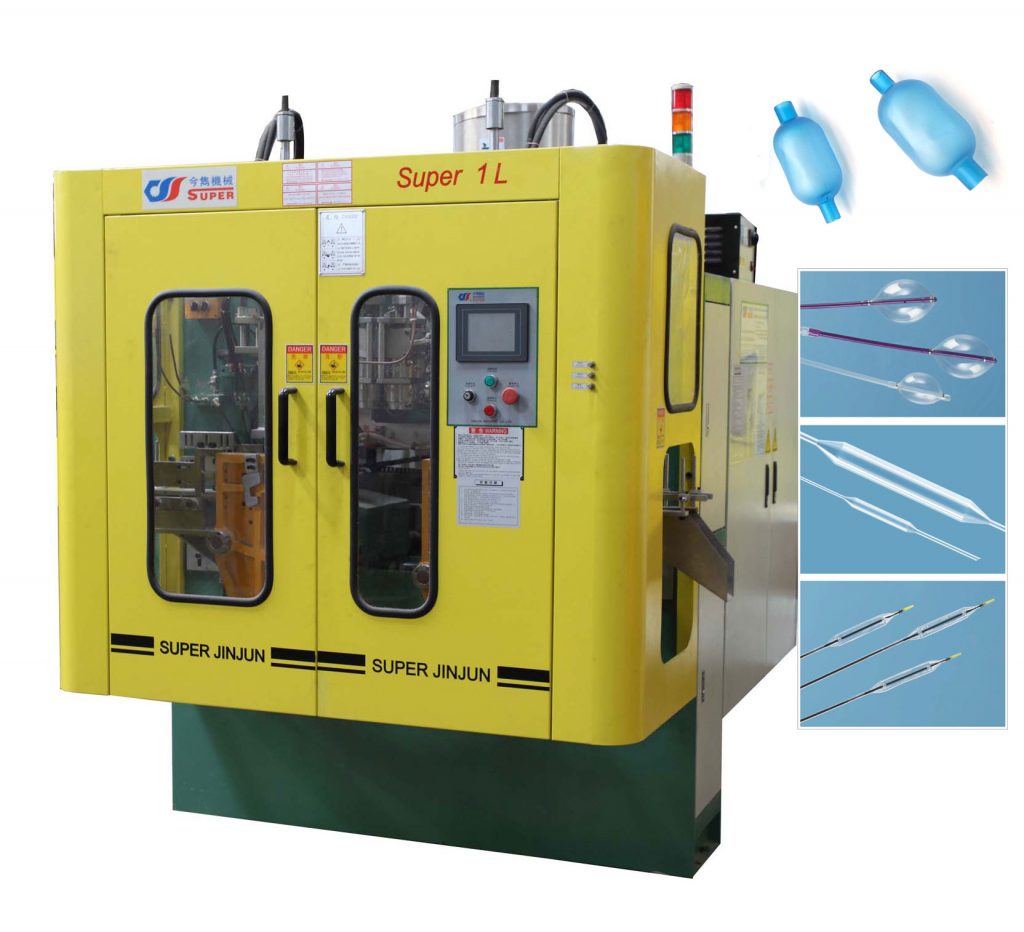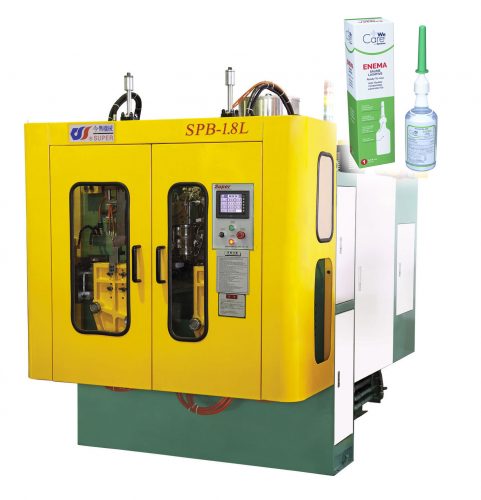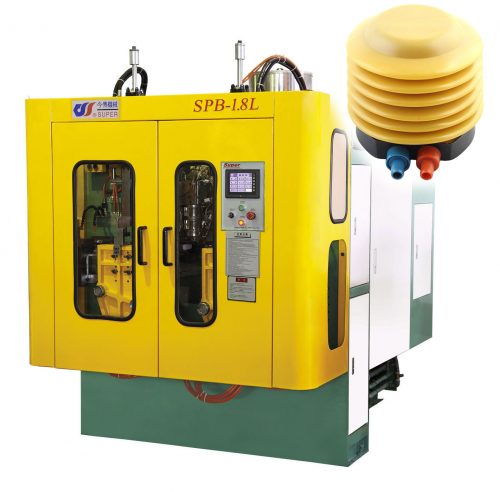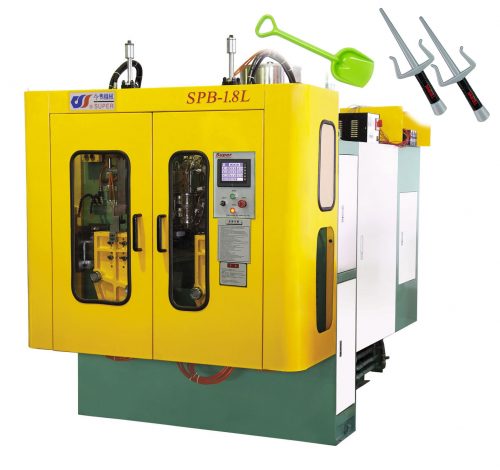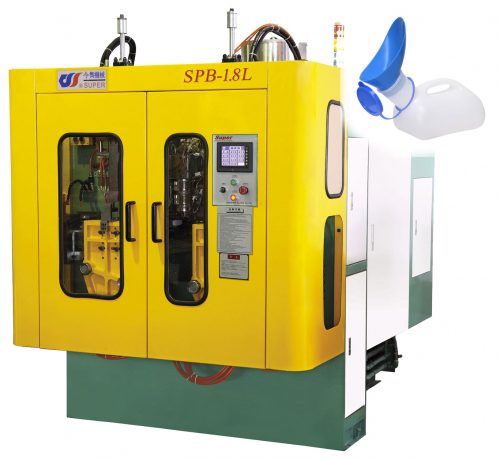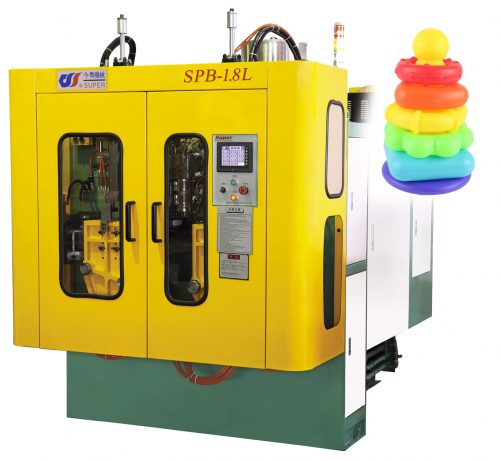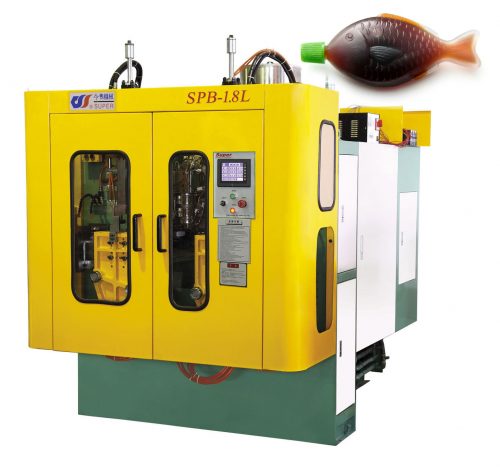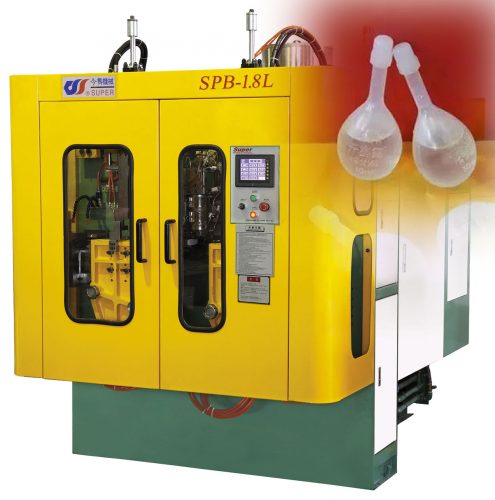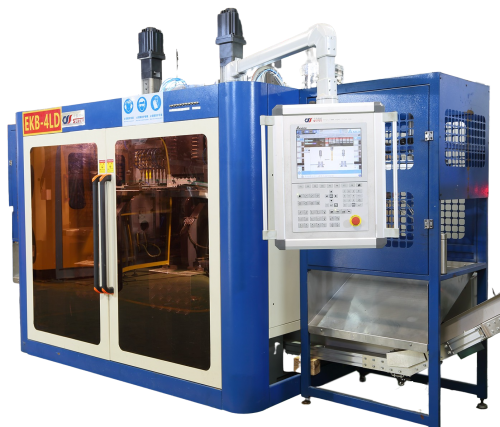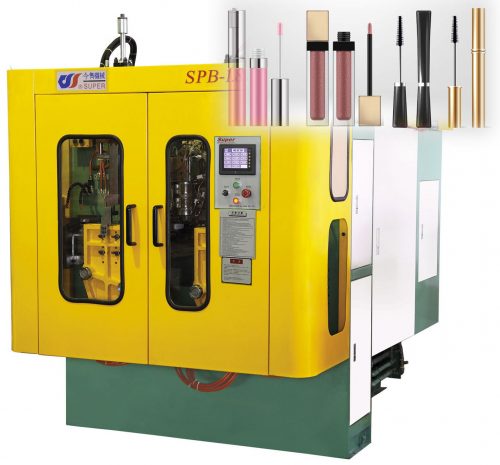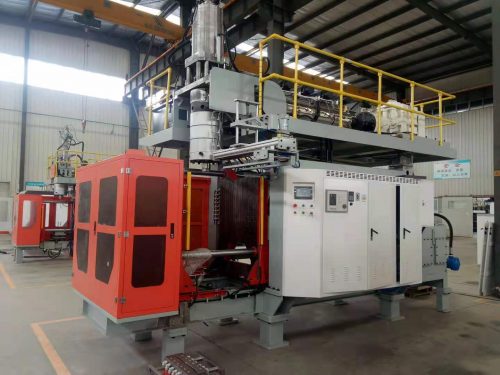Medical catheter balloons are typically made from a type of plastic called polyurethane. Generally, the manufacturing process for medical catheter balloons as below:
1. A long piece of polyurethane tubing is created on an extrusion machine. During extrusion, the polyurethane is melted and forced through a narrow opening, which shapes it into a tube.
2. Cut the tube into smaller sections, each of which will become a balloon.
3. Each section of tubing is heated and placed over a special mold that is the shape of the balloon. The tubing is then inflated, causing it to conform to the mold’s shape.
4. The inflated tubing is cooled rapidly, which sets its shape.
5. After the tubing has cooled, it is deflated and removed from the mold.
6. Finally, the balloon is attached to the catheter itself, giving the catheter the ability to inflate and deflate the balloon as needed.
Now our blow molding machine produces medical catheter balloons in a single step, put TPU or PVC material in the hopper of our this blow molding machine, then comes out finished medical catheter balloons.
Medical catheter balloons are widely used on medical applications, here’s the application list:
- PTA & PTCA
Medical catheter balloons are used for two main procedures in the field of cardiology: percutaneous transluminal angioplasty (PTA) and percutaneous transluminal coronary angioplasty (PTCA).
During a PTA procedure, a catheter with a deflated balloon at its tip is inserted into a blood vessel near the area of the blockage or stenosis. Once the catheter is in place, the balloon is inflated to compress the blockage or stenotic area against the vessel wall and widen the artery. This allows improved blood flow through the blocked or stenotic area.
In a PTCA procedure, a catheter with a deflated balloon at its tip is inserted into the coronary artery through a guide wire that has been inserted through the femoral artery. Once the catheter is positioned in the narrowed section of the artery, the balloon is inflated to compress the plaque or stenotic area against the vessel wall and widen the artery, restoring blood flow to the heart muscle.
Both PTA and PTCA procedures use specialized medical catheter balloons that can vary in size and shape depending on the specific area of the body being treated. The catheter balloon is an essential component for these procedures, as it allows for precise and localized expansion of the narrowed or blocked vessel segment to restore blood flow.
- Standard angioplasty
Standard angioplasty, also known as balloon angioplasty, is a medical procedure where a catheter with a deflated balloon at its tip is inserted into a blood vessel through a small incision in the skin. The catheter is guided through the vessel using X-ray imaging or other imaging techniques until it reaches the blocked or stenotic section of the artery.
Once the catheter is positioned in the narrowed segment of the artery, the balloon is inflated to compress the plaque or stenotic area against the vessel wall, expanding the artery and increasing blood flow through it. The balloon is then deflated and removed from the vessel, leaving the expanded artery open and allowing improved blood flow.
During this procedure, the medical catheter balloon is used to mechanically compress the plaque or stenotic area to widen the affected vessel segment. The balloon can be inflated and deflated multiple times, depending on the severity of the blockage, until the vessel is sufficiently opened and blood flow is restored.
Medical catheter balloons used for standard angioplasty come in different sizes to accommodate different vessel diameters. The choice of balloon size is determined by the physician based on the size of the vessel and the severity of the blockage. The diameter of the balloon must be larger than the diameter of the lumen of the artery for effective compression of the obstructing plaques or stenotic areas.
- Stent delivery
Medical catheter balloons are also used during stent delivery procedures. A stent is a small, expandable metal or plastic tube that is inserted into a blood vessel or other duct to hold it open or to maintain patency. Stents can be used as permanent implants to treat coronary artery diseases.
During a stent delivery procedure, a catheter with a collapsed stent and an attached deflated balloon is inserted into the narrowed area of the blood vessel. When the stent is in place, the balloon is inflated to expand the stent and push it against the vessel wall. This allows the stent to open up the narrowed area and restore proper blood flow.
The medical catheter balloon used for stent delivery is specially designed to fit around the collapsed stent and to expand it evenly. It is also designed to deflate easily and be removed from the body.
Once the stent has been expanded, the balloon is deflated and removed from the artery while the stent remains in place to help keep the artery open. A stent delivery procedure is often used in conjunction with balloon angioplasty to further improve and maintain blood flow.
Overall, the medical catheter balloon plays an important role in the delivery of stents, as it allows precise and controlled placement of the stent within the narrowed blood vessel while minimizing damage to the tissue in the affected area.
- Drug delivery/eluting
Medical catheter balloons are also used for drug delivery or drug-eluting angioplasty procedures. These procedures are used to reduce the likelihood of restenosis, which is the re-narrowing of a previously treated artery.
During a drug-eluting angioplasty procedure, a catheter with a deflated balloon at its tip is inserted into the narrowed segment of the artery. Once the catheter is in place, a specially designed drug-coated balloon (DCB) is inflated, allowing the medication to be delivered directly to the treated area.
The medication on the balloon is designed to dissolve slowly, releasing the drug over time and preventing or delaying restenosis. The drug-coated balloon helps to target and inhibit the formation of new lesions or plaque, thereby improving blood flow and reducing the risk of future blockages.
Medical catheter balloons used for drug delivery or drug-eluting angioplasty have specific coatings that enable the drugs to be released in a controlled manner over a desired time span. This allows for effective drug delivery to the treated area while minimizing any adverse effects that may arise from delivering drugs in a less targeted or less controlled manner.
Overall, medical catheter balloons used for drug delivery or drug-eluting angioplasty procedures can help to reduce the risk of restenosis and improve long-term outcomes for the patients. It is an important tool in the fight against cardiovascular disease.
- Cryoablation
Medical catheter balloons can also be used in cryoablation procedures for the treatment of various heart conditions, such as arrhythmias.
During a cryoablation procedure, a catheter with a cryogenic balloon at its tip is introduced into the heart through a vein and guided to the location of the tissue that is causing the abnormal heart rhythm. Once the catheter is positioned in the right location, the balloon is inflated with a refrigerant gas that freezes the surrounding tissue.
The frozen tissue is then thawed, causing it to die and scar, thereby blocking the improper electrical activity in the heart responsible for the arrhythmia. The balloon is then deflated and removed from the heart.
The medical catheter balloon used for cryoablation is designed to withstand the cold temperatures of the refrigerant gas and prevent any damage to the surrounding tissue. The balloon is also used to isolate the area being treated and ensure that the refrigerant gas only freezes the targeted tissue, allowing for precise and controlled ablation of the tissue.
Overall, medical catheter balloons used for cryoablation procedures can help to treat a variety of heart conditions, particularly arrhythmias, with improved precision and reduced side effects when compared to traditional ablation techniques.
- RF ablation
Medical catheter balloons can also be used for radiofrequency (RF) ablation procedures. RF ablation is a minimally invasive procedure used to treat certain heart conditions, such as arrhythmias, by targeting and destroying abnormal tissue that is causing the problem.
During an RF ablation procedure, a catheter with a small RF electrode at its tip is guided through a vein to the location of the abnormal tissue in the heart. The electrode emits high-frequency electrical energy to create heat, which destroys the abnormal tissue and creates a scar that can no longer conduct electrical activity.
The medical catheter balloon used in RF ablation procedures is designed to act as an electrode, providing both a pathway for the RF energy to reach the affected area and insulation to protect the normal tissue from damage.
The catheter balloon is made of a specialized material that can withstand the heat generated during the ablation process while keeping the surrounding tissue protected. It is also designed to improve the efficiency of the RF ablation by covering a larger area of tissue.
Overall, medical catheter balloons used for RF ablation procedures can help to treat a variety of heart conditions more effectively with reduced risk of adverse effects when compared to traditional surgical techniques.
- Aneurism treatment
Medical catheter balloons can also be used in the treatment of aneurysms. An aneurysm is an abnormal bulge or weak spot in the wall of a blood vessel, which can potentially rupture and cause life-threatening bleeding.
During an aneurysm treatment procedure, a catheter with a deflated balloon at its tip is inserted into the blood vessel and guided to the location of the aneurysm. Once the catheter is in place, the balloon is inflated to occlude the opening of the aneurysm sac, reducing blood flow and pressure inside the aneurysm.
The medical catheter balloon used in aneurysm treatment is designed to seal the opening of the aneurysm and prevent further expansion or rupture of the blood vessel. The balloon is inflated only as much as necessary to occlude the opening of the aneurysm, without causing any damage to the surrounding tissue.
Once the balloon is inflated, the aneurysm is either refilled with clotting agents or covered with stents or coils to keep the aneurysm from refilling with blood.
Medical catheter balloons used in aneurysm treatment are typically larger than those used in other procedures and are made of materials that can withstand the pressure of the occlusion. They are also designed to be deflated and removed safely and easily from the blood vessel after the procedure is complete.
Overall, medical catheter balloons used in aneurysm treatment can help prevent the risk of rupture and improve outcomes for patients with this serious condition.
- Thermal regulation
Medical catheter balloons can also be used for thermal regulation procedures. These procedures are used to regulate the body’s temperature in patients who are at risk of developing hypothermia or hyperthermia, or who are undergoing certain surgical procedures that require precise temperature control.
During a thermal regulation procedure, a catheter with a balloon at its tip is inserted into the patient’s body. The balloon is then filled with either hot or cold saline solution to adjust the patient’s body temperature to the desired level.
The medical catheter balloon used in this procedure is made of materials that can withstand the temperature extremes required for maintaining the desired body temperature. The balloon is often made of polyurethane or silicone and is designed to be flexible for easy insertion into the body and precise placement of the balloon in the target area.
The catheter balloon comes in different sizes and shapes depending on the intended use. For example, some balloons are designed for use in the esophagus for whole-body cooling, while others are designed for intravascular placement for localized cooling or warming.
Overall, medical catheter balloons used in thermal regulation procedures can help to regulate the body’s temperature precisely and effectively, improving outcomes and reducing the risk of complications due to temperature-related issues.
- Cancer radiation treatment
Medical catheter balloons can also be used in cancer radiation treatment procedures, specifically in high-dose rate (HDR) brachytherapy. HDR brachytherapy involves the placement of radioactive sources directly into or near a tumor, allowing for a more targeted and effective radiation treatment.
During an HDR brachytherapy procedure, a catheter with a deflated balloon at its tip is inserted into the tumor. Once the catheter is in place, the balloon is inflated to hold the radioactive sources in place and ensure that they are accurately positioned in the tumor.
The medical catheter balloon used for cancer radiation treatment is designed to be compatible with radiation and to hold the radioactive sources in place during the treatment. The catheter itself may be made of flexible or rigid materials, depending on the specific application and the physician’s preference.
Once the radioactive sources are in place, they are activated for a specific period of time before being removed. The balloon is then deflated and removed from the tumor. The radiation treatment can be repeated over a series of sessions until the desired radiation dose has been achieved.
Medical catheter balloons used in cancer radiation treatment can provide a more precise and targeted approach to radiation therapy, minimizing damage to surrounding healthy tissue and improving outcomes for cancer patients.
- Interventional Radiology
Medical catheter balloons are commonly used in interventional radiology procedures, which involve the use of minimally invasive techniques to diagnose and treat various conditions.
During interventional radiology procedures, a catheter with a balloon at its tip can be inserted into the body to achieve a variety of therapeutic goals. For example, a catheter balloon can be used to occlude a blood vessel during embolization procedures, to deliver medications to a specific area of the body, or to remove blockages in the urinary or biliary tract.
The medical catheter balloon used in interventional radiology procedures is designed to fit the specific requirements of the procedure and to withstand the physical and chemical stresses associated with the procedure. The balloon is often made of a thermoplastic polymer, such as polyethylene terephthalate (PET), and can come in various shapes, sizes and coatings depending on the specific medical application.
Interventional radiology procedures are typically minimally invasive and can be performed using a variety of imaging technologies, such as ultrasound, X-ray, magnetic resonance imaging (MRI), or computed tomography (CT) scans. These procedures can offer patients a less invasive option for diagnosis and treatment compared to open surgery.
Overall, medical catheter balloons used in interventional radiology procedures can help to improve outcomes for patients through more targeted and minimally invasive treatments.
- Embolic protection filtration
Medical catheter balloons can also be used for embolic protection filtration during certain medical procedures, such as during carotid artery stenting. During this procedure, a catheter with a filter device containing a balloon at its tip is inserted into the carotid artery.
Once the catheter is positioned at the site of the blockage, the balloon is inflated to isolate the treatment area from the rest of the blood vessel. This prevents debris from entering the bloodstream during the procedure.
Then, while the balloon is inflated, the filter device captures and prevents small particles, such as clots or plaque, from breaking loose during the procedure and traveling to the brain or other organs causing complications.
The medical catheter balloon used in embolic protection filtration is designed to occlude the blood vessel during the procedure without damaging the vessel walls or interfering with blood flow. The balloon is typically made of a flexible, medical-grade material, and is inflated to a specific size to fit the dimensions of the blood vessel being treated.
Overall, medical catheter balloons used for embolic protection filtration offer an important safety measure to prevent complications during certain medical procedures, such as carotid artery stenting, by keeping debris from entering the bloodstream.
- Emboli capture
Medical catheter balloons can also be used for emboli capture during certain medical procedures, such as in coronary artery intervention or peripheral arterial disease treatments.
During an emboli capture procedure, a catheter with a deflated balloon at its tip is inserted into the affected artery. Once the catheter is positioned, the balloon is inflated to temporarily occlude the artery and trap any embolic debris or clots.
The medical catheter balloon used in emboli capture is designed to safely and effectively trap the embolic debris or clot while minimizing damage to the surrounding tissue. The balloon is typically made of a special material that can withstand the pressure exerted by the blood in the artery.
After the debris or clot has been captured by the balloon, the balloon is deflated and removed from the artery, along with the debris, thus restoring normal blood flow.
Overall, medical catheter balloons used for emboli capture can help prevent the migration of potentially harmful embolic debris and reduce the risk of complications during certain medical procedures, such as coronary artery intervention or peripheral arterial disease treatments.
- Venous drainage
Medical catheter balloons can also be used in venous drainage procedures, particularly in extracorporeal membrane oxygenation (ECMO). ECMO is an advanced life support technique used to provide oxygen and circulatory support for critically ill patients.
During ECMO, a catheter with a balloon at its tip is inserted into a vein and passed through the heart into the pulmonary artery. The balloon is inflated to occlude the pulmonary artery and redirect blood flow from the heart directly to the ECMO machine, where it is oxygenated and returned to the patient.
The medical catheter balloon used in venous drainage procedures is designed to be flexible and durable, allowing it to navigate through the blood vessels and be inflated and deflated repeatedly without damage. The balloon is made of medical-grade materials that are safe for use in the body and can withstand the pressure of blood flow.
Overall, medical catheter balloons used in venous drainage procedures can help to provide life support for critically ill patients by directing blood flow to the ECMO machine and allowing for oxygenation and circulatory support until the patient is stabilized.
- Kyphoplasty
Medical catheter balloons can also be used in kyphoplasty, a minimally invasive surgical procedure used to treat vertebral compression fractures caused by osteoporosis or other diseases.
During the kyphoplasty procedure, a catheter with a deflated balloon at its tip is inserted through a small incision in the back and introduced into the fractured vertebral body. Once the catheter is positioned within the fractured bone, the balloon is inflated to create a cavity within the vertebra.
The medical catheter balloon used in kyphoplasty is designed to be durable and expandable to create a void cavity within the vertebral body. It is typically made of materials such as PET, polyamide, and nylon, which can withstand the pressures of the expansion process.
The balloon is designed to be easily inflated and deflated with a special liquid or gas, allowing for precise control of the expansion and the creation of a cavity within the collapsed vertebra. Once the cavity is created, bone cement is injected into the cavity to stabilize the fractured vertebra.
Overall, medical catheter balloons used in kyphoplasty can help to restore the structure and function of the vertebral body, reduce pain, and improve quality of life for patients suffering from vertebral compression fractures.
- Sinuplasty
Medical catheter balloons can also be used in a minimally invasive surgical procedure called sinuplasty, which is used to treat chronic sinusitis.
During sinuplasty, a thin catheter with a deflated balloon at its tip is inserted into the sinus cavity. Once the catheter is in place, the balloon is inflated to open up the sinus passageways, allowing for better drainage and ventilation.
The medical catheter balloon used in sinuplasty is designed to be flexible and durable to navigate through the sinuses. The balloon is typically made of medical-grade materials that can withstand the forces exerted during inflation and deflation.
Once the balloon is inflated and the passageway is opened, the balloon is deflated and removed from the sinus cavity. In some cases, medication or saline solution may be delivered through the catheter during the procedure to alleviate symptoms of sinusitis.
Overall, medical catheter balloons used in sinuplasty can help to improve nasal airflow and reduce symptoms associated with chronic sinusitis without the need for more invasive procedures such as endoscopic sinus surgery.
- Valvuloplasty
Medical catheter balloons can also be used in valvuloplasty, a minimally invasive procedure used to treat heart valve stenosis, a condition where the heart valve becomes narrowed or constricted, reducing blood flow.
During valvuloplasty, a catheter with a deflated balloon at its tip is inserted into the heart through a vein or artery. Once the catheter is positioned in the heart valve, the balloon is inflated, stretching the valve opening and increasing blood flow.
The medical catheter balloon used in valvuloplasty is designed to be flexible for easy insertion into the heart and durable to withstand the pressure of inflation and deflation. The balloon is typically made of medical-grade materials that can safely and effectively stretch the valve without causing damage to the surrounding tissue.
Once the valve has been opened, the balloon is deflated and removed from the heart, restoring proper blood flow. In some cases, a stent or other device may be inserted to keep the valve open and prevent further narrowing.
Overall, medical catheter balloons used in valvuloplasty can help to improve blood flow and reduce symptoms associated with heart valve stenosis, offering a less invasive alternative to traditional open-heart surgery.
- Heart valve replacement (TAVR & TMVR)
Medical catheter balloons can also be used in heart valve replacement procedures such as transcatheter aortic valve replacement (TAVR) or transcatheter mitral valve replacement (TMVR).
During a TAVR procedure, a catheter with a deflated balloon at its tip is inserted into the patient’s artery and guided to the heart valve. Once the catheter is in place, the balloon is inflated to expand the valve and create space for a new, specially designed valve to be placed inside the old, damaged one. The new valve is then expanded and used to replace the old valve, restoring proper blood flow.
Similarly, during a TMVR procedure, a catheter with a deflated balloon at its tip is inserted through a vein in the leg and passed through the heart into the mitral valve. Once the catheter is positioned in the mitral valve, the balloon is inflated to stretch the valve and create space for a new, specially designed valve, which is then expanded and used to replace the old valve.
The medical catheter balloon used in TAVR or TMVR procedures is designed to expand the valve to a specific size without damaging the surrounding tissue. The balloon is made of a specialized material that can withstand the pressure exerted during the procedure.
Overall, medical catheter balloons used in heart valve replacement procedures such as TAVR or TMVR can offer a less invasive alternative to traditional open-heart surgery, resulting in faster recovery times and reduced hospital stays.
- Esophageal dilatation
Medical catheter balloons can also be used in esophageal dilatation procedures, which are used to expand a narrowed or constricted section of the esophagus.
In this procedure, a catheter with a deflated balloon at its tip is inserted through the patient’s mouth into the esophagus. Once the catheter is positioned in the narrowed area, the balloon is inflated, stretching the esophagus and increasing its diameter.
The medical catheter balloon used in esophageal dilatation is designed to be flexible and soft enough to pass through the narrow esophagus. The balloon is typically made of silicone or other flexible materials that can expand the esophagus without damaging the surrounding tissue.
Once the esophagus has been expanded to the desired diameter, the balloon is deflated and removed from the body.
Overall, medical catheter balloons used in esophageal dilatation can help to alleviate symptoms associated with esophageal narrowing, such as difficulty swallowing or heartburn, and improve quality of life for patients suffering from this condition.
- Vascular closure
Medical catheter balloons can also be used in vascular closure procedures, which involve closing an artery or blood vessel after catheterization or interventional medical procedures.
During a vascular closure procedure, a catheter with a balloon at its tip is inserted through the vessel. Once the catheter is in place, the balloon is inflated, temporarily occluding the bloodstream.
This allows a closure device, such as a collagen plug or suture, to be introduced into the vessel to close the opening left by the catheterization or medical procedure.
The medical catheter balloon used in vascular closure procedures is typically made of a durable, biocompatible material that can withstand the pressure of the inflation and deflation process. The balloon is designed to be inflated to a specific size and shape, ensuring that it can effectively occlude the artery or blood vessel without damaging the surrounding tissue.
Overall, medical catheter balloons used in vascular closure procedures can help to reduce the risk of complications associated with catheterization or interventional medical procedures, such as bleeding or infection, by effectively closing the opening in the artery or blood vessel.
- Respiratory ventilation
Medical catheter balloons can also be used in respiratory ventilation procedures, specifically during endotracheal intubation or tracheostomy.
During endotracheal intubation, a catheter with an inflated balloon at its tip is inserted through the mouth and into the trachea to keep it open and allow for ventilation. The inflated balloon forms a seal that prevents air from escaping around the tube, enabling effective respiratory support.
Similarly, during tracheostomy, a catheter with an inflated balloon at its tip is inserted through a small incision in the neck and into the trachea. The balloon is inflated to keep the trachea open and facilitate respiratory ventilation.
The medical catheter balloon used in respiratory ventilation procedures is designed to be flexible and durable, allowing for easy insertion into the trachea. The balloon is typically made of medical-grade materials such as silicone or latex that can expand and form a tight seal around the tracheal tube.
Overall, medical catheter balloons used in respiratory ventilation procedures can help to ensure adequate ventilation and oxygenation in patients who require respiratory support, such as those with respiratory failure, severe infections, or surgical procedures.
- Renal
Medical catheter balloons can also be used in renal procedures, particularly in the treatment of kidney stones.
During a renal procedure, a catheter with a deflated balloon at its tip is inserted through the urethra, bladder, and into the ureter or renal pelvis, where kidney stones can form and cause blockages. Once the catheter is positioned in the affected area, the balloon is inflated, creating a seal in the ureter or renal pelvis.
The inflated balloon allows for increased irrigation flow and pressure, dislodging and flushing out the kidney stones. In some cases, medication or saline solution may be delivered through the catheter during the procedure to further dissolve the stones.
The medical catheter balloon used in renal procedures is designed to be flexible enough to navigate the curved ureter and durable enough to withstand the pressure of the inflation and flushing process. The balloon is typically made of a combination of medical-grade materials such as PET or nylon.
Once the kidney stones have been flushed out, the balloon is deflated and removed from the ureter or renal pelvis.
Overall, medical catheter balloons used in renal procedures can help to effectively clear kidney stones and prevent further blockages caused by these stones.
- Occlusion
Medical catheter balloons can also be used for occlusion procedures, which involve the intentional blocking of a blood vessel or other type of vessel or duct. This can be done for a variety of reasons, such as to treat a bleeding vessel, prevent blood flow to a tumor, or block blood flow before surgery.
During an occlusion procedure, a catheter with a deflated balloon at its tip is inserted through an appropriate vessel and positioned at the site that needs to be occluded. The balloon is then inflated, obstructing blood flow and preventing the passage of fluids or gases.
The medical catheter balloon used in occlusion procedures is designed to be flexible and durable, allowing the balloon to be navigated to the appropriate location and to withstand the pressure exerted during inflation. The balloon is typically made of medical-grade materials such as PET or nylon.
Once the procedure is complete, the balloon is deflated and removed from the vessel.
Overall, medical catheter balloons used in occlusion procedures can be effective in treating certain medical conditions where blocking blood flow or the passage of fluids or gases is necessary.
- Structural heart
Medical catheter balloons can also be used in structural heart procedures, which involve the use of minimally invasive techniques to treat heart defects or structural abnormalities.
During a structural heart procedure, a catheter with a deflated balloon at its tip is inserted through a vein or artery and guided to the heart. Once the catheter is in position at the site of the defect or abnormality, the balloon is inflated to create a larger opening or space within the heart’s chambers or blood vessels.
For example, medical catheter balloons can be used to expand the atrial septum during atrial septal defect (ASD) closure procedures, or to enlarge the opening in the pulmonary valve during pulmonary valve stenosis procedures.
The medical catheter balloon used in structural heart procedures is designed to be flexible and durable to navigate through the heart’s chambers, and made of materials that can withstand the pressure exerted during inflation and deflation.
Once the procedure is complete, the balloon is deflated and removed from the heart through the same catheter.
Overall, medical catheter balloons used in structural heart procedures offer a minimally invasive and effective alternative to traditional open-heart surgery, allowing for precise treatment of heart defects and structural abnormalities.
Check this video to see how our machine produces polyurethane (TPU) medical catheter balloons:
